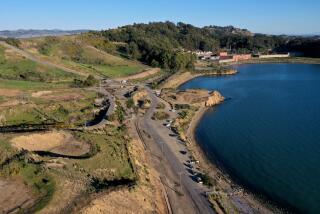Shining light on the past
- Share via
MONTARA, CALIF. — In the world of lighthouse fanciers, the news was like a sudden flash through the fog: Never the biggest or brightest, the lighthouse here that guides mariners into San Francisco Bay has been revealed as perhaps the only bicoastal beacon in America.
For 80 years, the Point Montara light has scanned the cold waters off the coast, warning sailors away from rocky shoals. But in an earlier, hitherto secret life, it turns out, it ushered fishermen into foggy Wellfleet Harbor on Cape Cod.
How the cast-iron structure, now known to be 127 years old, made its way from coast to coast is still a mystery. But it seems clear that Point Montara’s light has swung over both the Atlantic and the Pacific -- a feat to which no other lighthouse has laid claim, according to experts in the field.
Disclosed in the June issue of the Maine-based Lighthouse Digest, the startling find is based on recently unearthed government documents.
“I was, like, pumping my arm in the National Archives, going, ‘Yes! Yes! I’ve got it!’ ” said Colleen MacNeney, the researcher who followed a complicated paper trail to nail down the lighthouse’s provenance.
Visible from 12 miles off the coast, the Point Montara light is operated by the Coast Guard but is the centerpiece of a hostel catering to travelers wandering California 1 between San Francisco and Half Moon Bay.
“It’s fantastic,” said Chris Bauman, manager of the Point Montara Lighthouse Hostel. “Two separate oceans, a century of service. And nobody ever knew it!”
Its white paint peeling and its windows frosted with salt spray, the 30-foot-tall lighthouse sits on a cliff thick with ice plant. Far below, waves crash on rocks, sea birds dive for fish and seals occasionally sun themselves in a secluded cove.
“This really answers a question I’ve had for a long time,” said Bauman, an artist who lives with his wife and two young daughters in a Victorian house on the lighthouse grounds. “I’d seen pictures of an 1880 lighthouse in exactly the same style at Lake Champlain in Vermont and thought: ‘Why do we have a New England-style lighthouse here that was supposedly built in 1928?’ It didn’t add up.”
At the 50-bed hostel, bicyclists and budget travelers pay as little as $20 a night for a berth in one of the converted barracks occupied by the Coast Guard before the light was automated decades ago. They sip espresso as they gaze out a huge kitchen window with a hypnotic view of mountains tumbling into the sea. Meditation sessions are offered every Wednesday night.
Some 3,000 miles to the east, Jim Walker of Hyannis, Mass., was pondering the fate of the lighthouse that once marked the nearby coast.
“For I don’t know how many generations, everyone was under the impression that it was destroyed and never to be found,” said Walker, a retired Coast Guard employee who heads the Cape Cod branch of the American Lighthouse Foundation. “The fact that it still exists is quite exciting.”
Walker knew that the old harbor light at Wellfleet had been dismantled in the 1920s.
“It gave the fishermen a general idea of where to head at the end of the day,” he said. “But over the years, the harbor silted in and became too shallow. The fishing fleet went elsewhere.”
So did the lighthouse.
The first clue was uncovered by Bob and Sandra Shanklin, a couple from Fort Walton Beach, Fla., who call themselves “the lighthouse people.” During 18 years, the Shanklins photographed every one of America’s roughly 670 lighthouses, hopping aboard ferries and small planes to capture the most remote.
“I’ve always enjoyed these ‘if-we-don’t-do-it-then-who-will’ kind of projects,” said Bob Shanklin, 82.
Rummaging through lighthouse materials in the National Archives, the Shanklins found a 1928 photo with a notation indicating that the new Point Montara light had operated at Mayo Beach in the U.S. Lighthouse Service’s District 2, which included Cape Cod. The service, now mostly forgotten, had existed for 150 years before being absorbed by the Coast Guard in 1939.
Seeking some explanation, the Shanklins’ daughter, MacNeney, plowed through lighthouse station logs, annual reports and Lighthouse Service bulletins.
“Every box was like Christmas for me,” she said.
Finally, she found a 1928 note from J.S. Conway, the acting commissioner of lighthouses, confirming the tower’s transfer.
Lighthouse relocations weren’t unknown, said Jeff Gales, executive director of the U.S. Lighthouse Society.
“The Lighthouse Service was always struggling for money, so the idea they’d want to save a few bucks and reuse a lighthouse is not a big jump,” said Gales, whose office is in a lighthouse on Puget Sound in Washington state. “But transporting a lighthouse across the U.S. -- that’s unusual.”
How the Point Montara lighthouse made the trip is an open question. Experts speculate that it could have been loaded on a ship, taken through the Panama Canal and deposited in pieces at a Lighthouse Service facility on Yerba Buena Island in San Francisco Bay.
The question intrigues MacNeney no less than the wave of public interest generated by her story in an obscure lighthouse journal.
“Maybe we’re just fascinated by any point of light in the darkness,” she said. “Maybe it’s like staring at a fire and being captivated. A lot of people see lighthouses as the eye of God.”
--
More to Read
Sign up for The Wild
We’ll help you find the best places to hike, bike and run, as well as the perfect silent spots for meditation and yoga.
You may occasionally receive promotional content from the Los Angeles Times.







